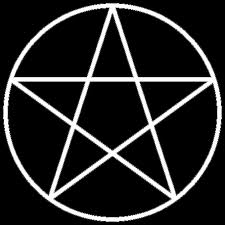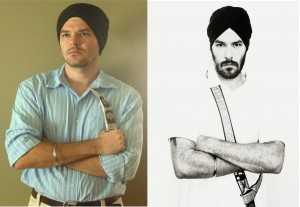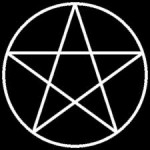Every month, I die and rise again. Like a Phoenix, my spirituality ignites every 30 days and a new faith rises from the ashes. This month, those ashes reconfigured into the path of Wicca.
Merry Meet, Blessed Be, and welcome to my first day on the Wiccan path! The first few days are always the hardest when I switch faiths. So much energy swarms around the house as I prepare for my transformation–so much so that I rarely sleep. I got lucky this month and had about three whole hours of shut-eye last night! Woohoo! I mean, how can you sleep with this much awesome going on in life?
So what is a Wiccan and what is Wicca? To be honest, this month feels like Hinduism (the Eternal Dharma) did. That isn’t to say the faiths are the same, only the approach to them. Here’s why: Both paths are huge. Just as there are no two identical Hindus, there are also no two identical Wiccans. Put 15 in a room and you’ll get 20 traditions. Wicca is a very broad umbrella term that describes many ways, so the best thing for me was to actually choose a specific tradition. My Mentor this month (Hey Mentor Melissa!) is a High Priestess of the Fey Tradition, so that is my path as well and most of the information I share this month will come from this perspective. I will do my best to point out otherwise. But before we go into that, let’s cover the basics Wiccan beliefs that most if not all Wiccans share.

—Defining what Wicca is depends on the practitioner (one who follows a Wiccan path) you ask. Much of modern Wicca as we know it today was developed in the early 1900’s by authors such as Gerald Gardner who are said to have initiated in the old Pagan ways of northern Europe. In this way, Wicca could be described as a revival movement, or a restoration of the old ways. Different traditions within Wicca have various roots and origins.
—Most Wiccans believe in the God and Goddess in some form. Some may only worship or actively engage one over the other (usually the Goddess), however the important aspect is the recognition of a higher power and/or energy.
—This belief in the God/Goddess aspect reflects the Wiccan belief in duality in nature and its balance, flow, etc.
—Wiccans typically hold all material–living and non-living–as having its own energy or life force. Even stones bear this energy. Life itself is usually sacred and highly regarded.
—Wiccans believe that the energy in all things can be manipulated or channeled. This is where the practitioner becomes an active agent in his/her environment. Wiccans mould and control their lives via this energy in the same way a conductor orchestrates the pieces of a symphony. Learning this energy manipulation is one of the most important aspects of the Wiccan path.
—Wiccans, because they believe in the importance of balance, also believe in the law of reciprocity. Often referred to as “the law of three”, Wiccans maintain that whatever one does, he/she is responsible for the consequences. The so-called Wiccan Rede formulated by Gerald Gardner states “An it harm none, do as you will.” Basically, if it hurts no one, go ahead. Wicca does not have a list of “do’s” and “do not’s.” All Wiccans must understand the power they wield and are solely responsible for the karma they produce.
That’s Wicca in a nutshell: An “earth-based” faith which focuses on the duality of the God/Goddess, the energy of all matter, its manipulation, and the law of reciprocity. Wiccans are not blood-drinking Satan worshippers. Satan is a Judeo-Christian construct and therefore has no place in Wicca. Wiccans do not believe in a central evil figure like Satan, so to imply that they worship him is insulting. I can tell you right now that I fully intend on crushing as many stereotypes as I can this month about Wicca because it’s the only faith thus far that I’ve actually received negative comments about. Know this: My service belongs to each faith, each month, and therefore my loyalties and energies go into supporting those faiths–mostly via defeating ignorance, prejudice, and stereotypes.
So what is Fey Wicca?
Fey Wicca is fun, however with balance! The word “Fey” denotes faeries (also spelled fairy), legendary spirit beings said to be small and inhabit nature itself. They are known by believers as quick to hide, mischievous, helpful, playful, and generally good, though a “dark side” is present. Fey Wicca draws its lore and stories mostly from the Irish legends and the Pagan tradition of the ancient Celts from that area. There really is no written tradition (such as a universal holy book) as far as the Fey Wicca is concerned and therefore most of the lore and learning is passed down orally.
In this way, Fey Wiccans are typically a fun-loving group–much like the faeries themselves–and are known for their lighter, more spontaneous take on life.
“If you haven’t found joy or a reason to laugh during the day, you’re wasting your time.” –Mentor Melissa
Laying down the law on day one, huh?
My Mentor stressed the importance of Wicca’s exploratory nature in general, that the faith is literally what you make of it. That isn’t to say that you should simply invent what you believe, but only that the foundation of your practice is founded upon your experience. What works, keep. What doesn’t work, toss out. Live. Laugh. Learn. And don’t worry too much about the particulars. Wicca in general is a meditation on life and worshipping the divine by interacting with it in every moment. It’s about channeling one’s energy and the mingling with the energy of everything around you. That said, each tradition has its own methods for doing this.
The challenge for me this month will be to not take myself too seriously. While I enjoy Project Conversion greatly, sometimes I get caught up in the process instead of the journey. This is when the details slip my notice. Fey Wicca is the court jester–the mirror–showing me how ridiculous and unhealthy such a path can be.
I look forward to laughing…a lot. I hope you’ll join me. Tomorrow we’ll take a look at my altar, one that bears my sweat and blood…literally.

